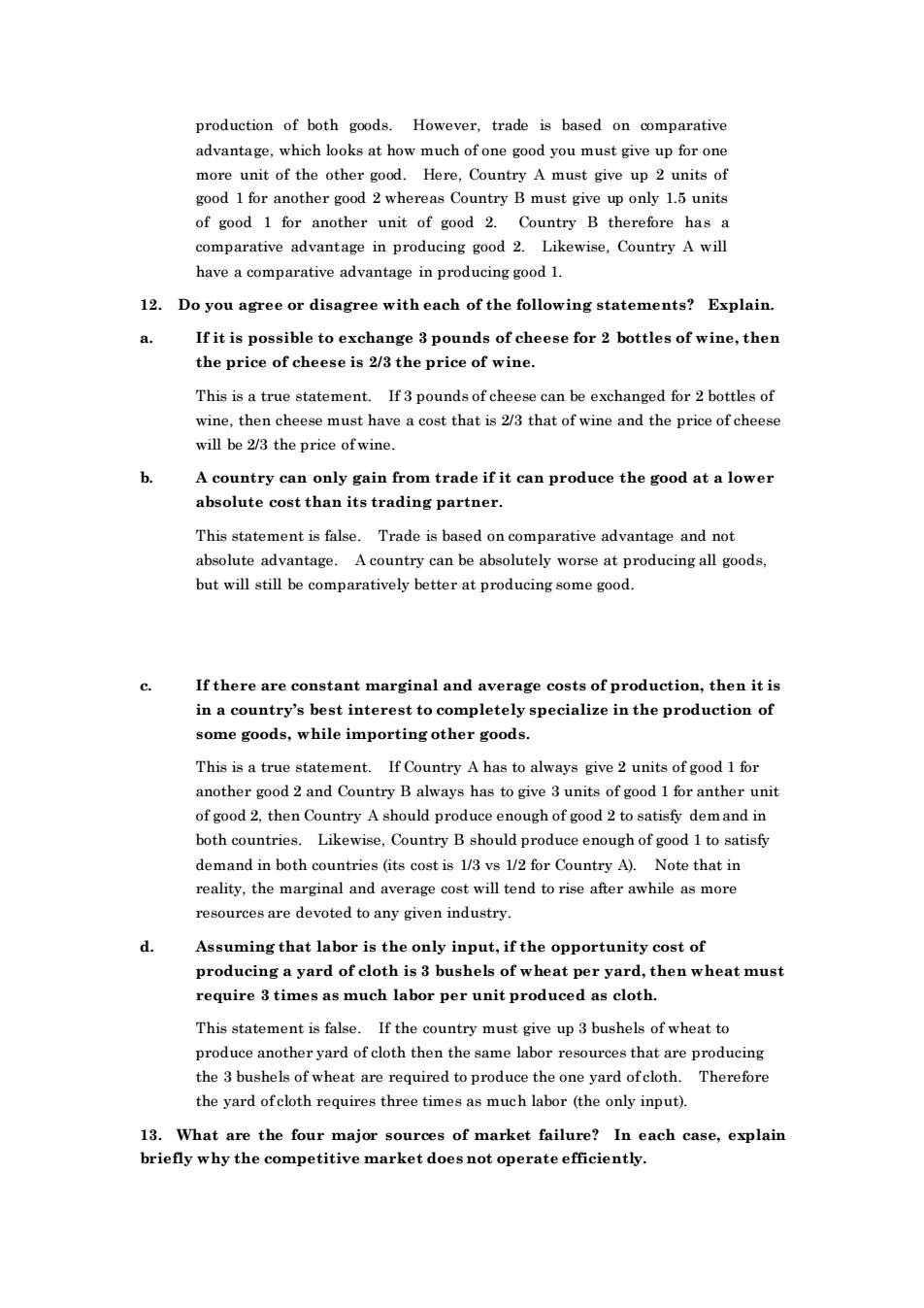正在加载图片...

production of both goods.However,trade is based on comparative r one more unit of the other good Here,Country A must give up 2 units of good 1 for another good 2 whereas Country B must give up only 1.5 units of good 1 for another unit of good 2.Country B therefore has a comparative advantage in producing good 2.Likewise,Country A will have a comparative advantage in producing good 1. 12. Do you agree or disagree with each of the following statements?Explain If it is possible to of cheese for 2 bottles of wine,then the price of cheese is 2/3 the price of wine This is a true statement.If 3pounds of cheese can be exchanged for 2 bottles of wine,then cheese must have a cost that is 2/3 that of wine and the price of cheese will be 2/3 the price of wine. A country can only gain from trade if it can produce the good at a lower absolute cost than its trading partner. This statement is false.Trade is based on co arative advantage and not ntage y can be abs ely worse at producing all goods but will still be comparatively better at producing some good If there are constant marginal and average costs of production,then it is in a country's best interest to completely specialize in the production of some goods,while importing other goods. This is a true statement.If Country A has to always give 2 units of good 1 for another good 2 and Country B always has to give 3 units of good 1 for anther unit of good2 the Country Ashould produe ugh of good 2t atisfy der mand in both countries Likewise.Country B should produce enough of good 1 to satisfy demand in both countries (its cost is 1/3 vs 1/2 for Country A). Note that in reality,the marginal and average cost will tend to rise after awhile as more resoures are devoted to any given industry. Ass ming that labor is the only input,if the opportunity cost of pro g a yard of c th is3 bushels of whe at per yard,then wheat must require 3 times as much labor per unit produced as cloth This statement is false.If the country must give up3bushels of wheat to produce another yard of cloth then the same labor resources that are producing the 3 bushels of wheat are required to produce the one yard ofcloth.Therefore the vard ofcloth requires three times as much labor (the only input). 13.What are the four major sources of market failure?In each case,explain briefly why the c aket do s not operate eproduction of both goods. However, trade is based on comparative advantage, which looks at how much of one good you must give up for one more unit of the other good. Here, Country A must give up 2 units of good 1 for another good 2 whereas Country B must give up only 1.5 units of good 1 for another unit of good 2. Country B therefore has a comparative advantage in producing good 2. Likewise, Country A will have a comparative advantage in producing good 1. 12. Do you agree or disagree with each of the following statements? Explain. a. If it is possible to exchange 3 pounds of cheese for 2 bottles of wine, then the price of cheese is 2/3 the price of wine. This is a true statement. If 3 pounds of cheese can be exchanged for 2 bottles of wine, then cheese must have a cost that is 2/3 that of wine and the price of cheese will be 2/3 the price of wine. b. A country can only gain from trade if it can produce the good at a lower absolute cost than its trading partner. This statement is false. Trade is based on comparative advantage and not absolute advantage. A country can be absolutely worse at producing all goods, but will still be comparatively better at producing some good. c. If there are constant marginal and average costs of production, then it is in a country’s best interest to completely specialize in the production of some goods, while importing other goods. This is a true statement. If Country A has to always give 2 units of good 1 for another good 2 and Country B always has to give 3 units of good 1 for anther unit of good 2, then Country A should produce enough of good 2 to satisfy demand in both countries. Likewise, Country B should produce enough of good 1 to satisfy demand in both countries (its cost is 1/3 vs 1/2 for Country A). Note that in reality, the marginal and average cost will tend to rise after awhile as more resources are devoted to any given industry. d. Assuming that labor is the only input, if the opportunity cost of producing a yard of cloth is 3 bushels of wheat per yard, then wheat must require 3 times as much labor per unit produced as cloth. This statement is false. If the country must give up 3 bushels of wheat to produce another yard of cloth then the same labor resources that are producing the 3 bushels of wheat are required to produce the one yard of cloth. Therefore the yard of cloth requires three times as much labor (the only input). 13. What are the four major sources of market failure? In each case, explain briefly why the competitive market does not operate efficiently